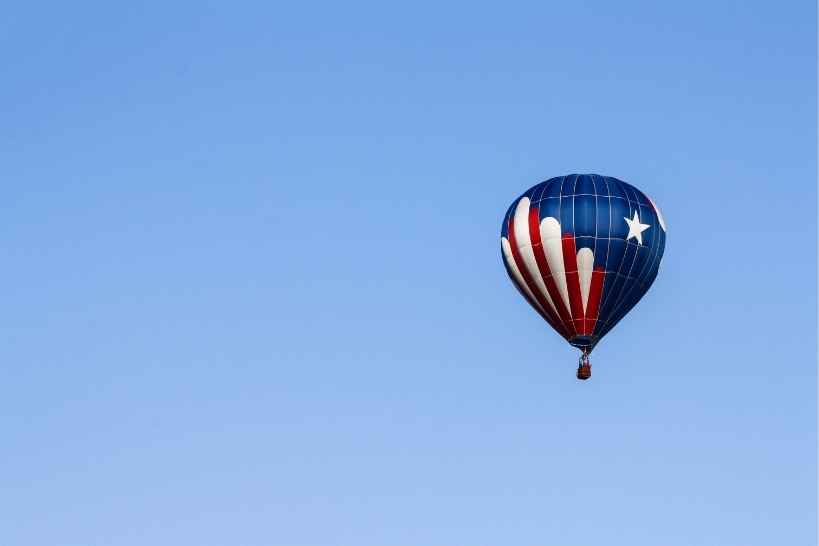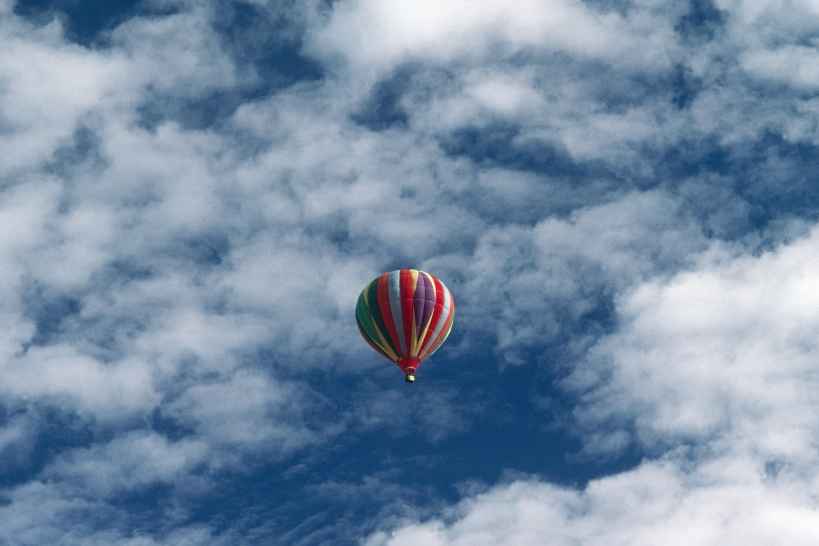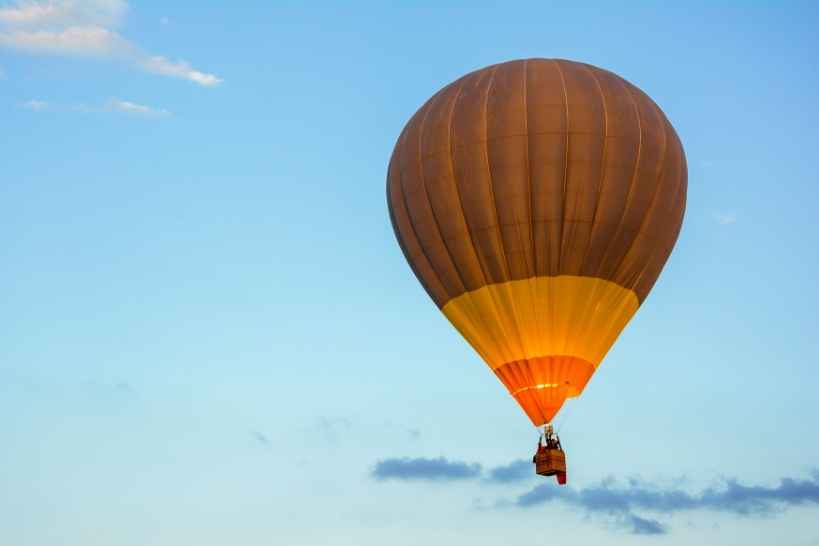The idea of “lighter than air” travel has always presented an interesting idea throughout the history of ballooning. If a balloon is lighter than air, how far can it rise? You may have learned about various things in school such as atmospheric pressure, air density, convection, and more. So how do they affect a hot air balloon ride?

How high do hot air balloons go? Hot air balloon companies typically operate in a range of 1000 to 3000 feet. However, this is well below the records limits set by a manned balloon. A hot air balloon business naturally favours safety and a comfortable experience over record setting.
Although a comfortable ride, a professional hot air balloon pilot can push a well designed balloon to the limit, and climb much higher. These aren’t small records, and certainly aren’t for those with a fear of heights.
Maximum Altitude
The current world record for highest altitude achieved with a hot air ballon was set by Vijaypat Singhania. Singhania would go on to reach the sorts of heights that smash previous records in Mumbai, India – 69,850 feet. This broke the hot air balloon record set in 1988 by Per Lindstrand in Texas, who reached 64,997 feet. An impressive record he held for nearly two decades.
What may be more impressive is the fact that Vijaypat Singhania set this record at the age of 67, certainly being among the most senior of hot air balloon enthusiasts at the time. One of the greatest accomplishments in balloon history, the 2005 record still stands uncontested to this very day.
A hot air balloon altitude record typically require a specially-designed balloon, so your average commercial or sport balloon wouldn’t reach such insane heights. Even if you asked your pilot very politely to go further up. You would also encounter freezing temperatures, and most aviation authorities forbid commercial and sporting balloons from going above the cloud layer.
Minimum Altitude
Hot air balloon flights may do their best to not exceed 3000 feet, but a minimum altitude is also important. Save for the occasion when a hot air balloon lands, a pilot will typically fly above the 1000 foot thresh-hold to avoid accidents. Collisions with buildings in urban areas, or even worse could be getting a balloon tangled in a power line.
Minimum altitudes form a part of basic safety precautions, mitigating risks when hot air ballooning. Other safety standards and safety procedures include routine checks and trained crew to ensure a pleasant experience while flying.

Oxygen Levels and Health Risks
Flying so high can be seriously risky, since air density can create problems with thinning oxygen in the air. Fortunately, at 3000 feet this is unlikely to affect you unless you have a pre-existing health condition. So be sure to make sure you are fit to fly before your viewing experience.
Higher altitude temperatures will also differ from the ground temperature, and can easily grow quite cold. For record setters this is especially true, but for the average one or two hour hot air balloon ride it is still important to prepare by wearing comfortable clothes.
The burner will provide some heat in the colder atmosphere as well, helping to warm you to the familiar temperature of the ground surface. Once the pilot sets you back on the ground level, any chills you felt can quickly fade, provided you’re flying on a temperate day.
Motion sickness is unlikely to affect you during a flight, but informing your hot air balloon pilot prior to departure can improve your entire experience. They may have ways to help mitigate any adverse feelings you may have during the flight.
In case of an emergency, they can also find some potential landing sites to get you back on the ground level. Wind speeds can vary but at an average of five miles per hour, a balloon heavier with a fully loaded basket will not reach intense speeds.
Other Safety Factors
Most other health risks associated with sudden changes in ballooning conditions and with landing. A sudden change into harsh conditions will force most hot air balloon companies to postpone or cancel flights. Both to protect customers, and wear and tear on the balloon envelope which would prevent the balloon from lifting correctly.
Most ballooning businesses and ballooning websites will be able to boast of a flawless safety record, if they are a credible business or group. If you are unsure at any point, ask the crew or relevant staff about safety apparel requirements, and other checks prior to flying.
Remember to raise any concerns to the pilot or company during or prior to your scheduled meeting time, and be prepared for a bumpy landing. Air balloons do not come with engines or landing gear.
You may be concerned that a hot balloon can lead to a fuel ignition, or burner failure. However, this is not always the case. In extreme heat conditions, it is most likely that a hot balloon would not be able to lift and take off, but would otherwise be fine remaining in storage.
Hot air balloon developers and the use of nylon material also prevent sudden breakages in the balloon. While large enough that birds will avoid it, theoretically the material of a balloon should be strong enough to withstand a collision, and you’re not likely to see any holes unexpectedly.
Other Balloon Records
Using convection and hot air is not the only way to lift a balloon, and there have been a number of helium filled balloon world records over the years. The current record, performed in New Mexico, reached heights above 25 miles. So high in fact, that it is considered to be in the stratosphere.
In terms of longest balloon flights, Per Lindstrand would cross the Pacific ocean using a custom-designed ‘Virgin Pacific Flyer’ balloon. During this more than 4700 mile journey, the balloon would reach speeds of 245mph, a record for the highest ground speed of a piloted balloon. The balloon itself was also an impressive 2.6 million cubic feet, certainly a larger sized balloon.
Not to be outdone, Bertrand Piccard and Brian Jones would circumnavigate the globe. Travelling roughly 25,000 miles from Switzerland to Cairo in just 20 days, obliterating all records set previously. Hot air balloon history also has records for similar achievements with only a single pilot.

Weight Restrictions
International ballooning is a once in a lifetime experience, so you may be curious about weight limits and restrictions. Passenger weights as well as the weight of other equipment and the pilot can affect a balloon ride, but smaller groups rarely exceed more than 16.
This allows you and your fellow passengers to fly easy, and lets the ballooning business plan ahead with fuel and timing. So focus on enjoying your unforgettable experience, and raise any concerns you have with weight limits with the air balloon company you have selected to fly with.
An air balloon business works with various sized balloons, whether you are seeking a more private ride or a group flight. No matter the limit, there will almost certainly always be a flight waiting for you, at a competitive balloon ride cost. Whether that be a sunrise balloon flight, or a later time of day.
I’m Annie, a twenty-something year old girl who loves hot air balloons. So much so, that I have a full time job as a Flight Instructor and it is all I love talking about. Something about being up there in the elevated altitudes helps all my stresses float away!
